the radiance of cherry blossoms, their scent,
ever fresh with every passing year –
so man grows old, eternally
-Kino Tomonori
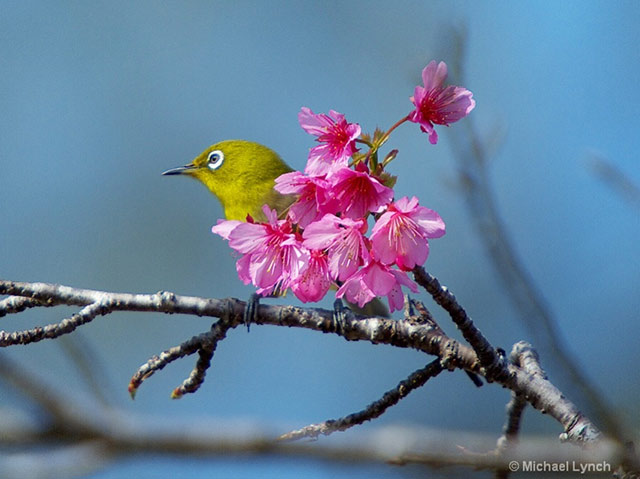
Japanese White Eye in Cherry Blossoms
Pentax K10D, Sigma 50-500@500mm, f/8, 1/640, ISO 100.
Through the winter months, barren trees line Japanese roads and the seaside. They grimly lead travelers through dense forests and up mountains to old shrines for prayer. Then Spring begins to warm Japan once more, giving the empty branches a burst of vivid color. The once cold walks become warm strolls up long mountain passes as gentle breezes coax hundreds of beautiful pink petals to swirl in the new air.
All around the world, Spring announces its return with the chirping of birds and blooming of flowers. In Okinawa, it is the blooming of a unique variety of Sakura (cherry blossoms). Their signal of Spring starts with the cold winds of winter, which is comparable to an East Coast autumn or early spring in the U.S. Suddenly the greens and browns are dressed with soft pinks and bright reds. It is the triumphal yet brief return of the long departed Sakura–Japan’s symbols of rebirth and the unofficial national flower. The Sakura season starts in January, as the cold winds rise from the ocean and flow through the island trees and color the air with pink petals swirling to the soft earth and thick jungle below. It spreads up into the mainland by late March and leaving pink-and-white footprints north through April and into May until the last tree blooms in northern Hokkaido. The contrast of these new colors against the vivid green of the lush jungles and tropical palm trees is astounding.
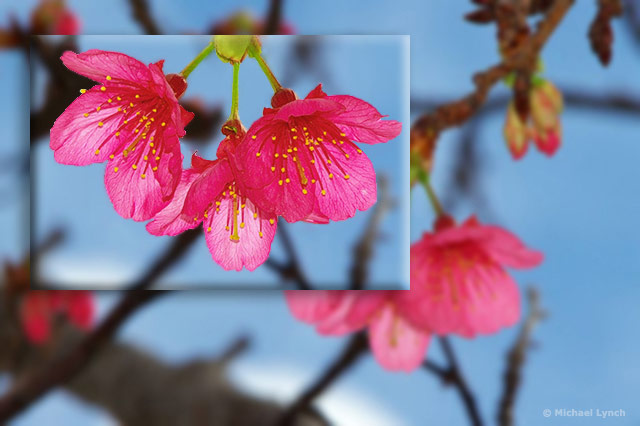
The golden anthers & pistils within the bell shape of the Sakura.
Pentax K10D 18-250@250mm Camera Flash, f/20, 1/125, ISO 200
Okinawa is the first of the islands to see the Sakura bloom and thousands of people from around the world watch with envy as the beautiful flowers are showcased on national broadcasts. The light and deep pinks of the petals clinging to each Taiwanese imported tree suddenly burst into the sunlight in eager celebration of the New Year. Okinawans flock to mountain shrines to join the celebration and spend as many peaceful days under the blossoms as they can before such fleeting beauty passes.
Not only is the arrival of the Sakura an anticipated event, but many Japanese take it very seriously. Daily reports of the Sakura Blossom Front, or Sakura Zensen, are given, tracing the blooming timeline until it reaches the cold regions of Hokkaido in Northern Japan. While celebratory festivals are being planned, the weather and temperatures are carefully tracked until the exact time of the peak blooming can be determined.
Okinawa’s personal Sakura front is atypical. The trees found on that island are actually imports from Taiwan of the Kanhi variety, known to bloom earlier in the spring and possess characteristics almost opposite of those of the trees found on mainland Japan. Their flowers bloom from north to south and hang with their petals reaching the ground, encasing the golden anther and pistils in a shape that resembles a bell. Also, unlike the almost pure white blossoms of the Somei Yoshino Sakura, their flowers blush in a range of soft pastel pinks to deep, rich pinks that may almost be considered red at times.
The Serenity of the Sakura
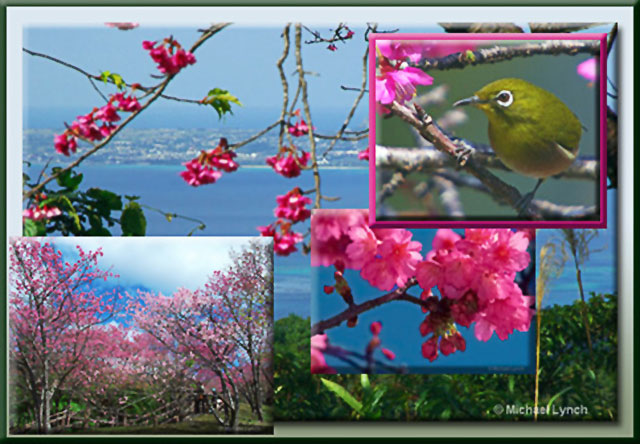
Background photo: Far in the background of this photo is Ie Shima, the island, where Pulitzer Prize recipient Ernie Pyle expired during World War II.
Pentax K10D, f/22, 1/250, ISO 200
Upper right: No time for a tripod; to catch the fast-moving Japanese White Eye in a pose like this, handheld is the way to go.
Pentax K10D Sigma 50-500@500mm. The image was steadied by wrapping the fingers of the hand holding the lens through a chain link fence.
Lower right: Cherry tree buds and blossoms captured on a windy day using camera flash.
Pentax K10D, 18-250@250mm, f/16, 1/125, ISO 200
Lower left: Artists and photographers, alike, take advantage of the burst of color on the mountains during Cherry Blossom Season.
Pentax K10D, Pentax 18-250@18mm, Manfrotto 725B, Cable Release f/18, 1/200, ISO 200
The very first place in all of Japan to see the tiny Sakura buds break out from the harsh, rough brown bark of the tree branches is be Motobu Town. Mount Yaedake has the honor of holding the very first Sakura festival of the year, followed closely by the Nago Cherry Blossom Festival. Tents are raised and the sound of the Taiko, or drum used in a traditional Okinawan Eisa dance, will boom out and resonate off each branch of the Sakura tree. Families and friends will meet under the branches and enjoy long strolls along paths lined in pink. During the brief life of the Sakura, many try to capture the visual memories with their cameras, freezing happiness in portraits that use a backdrop of Sakura against the crisp blue sky–toddlers with their eyes on the bright flowers in the sun, college friends laughing and drinking sake, lovers holding each other in the romantic atmosphere. It is truly astounding how something with such a fleeting existence can be the beginning of so many memories. The blooming of the Sakura is a time for companionship and celebration. Blue tarps are laid out over pools of fallen petals continuing the old tradition of hanami or flower viewing parties. The women, generally, will have spent many hours lovingly and artfully making many Bentos for the family to enjoy during their picnic under the trees; a packed lunch usually consisting of a combination of rice, fish, meat and other Japanese foods. Awamori, an Okinawan sake, is poured as the phrase “Kanpai!” (empty the glass) can be heard in cheers to the beginning of a good year to come.
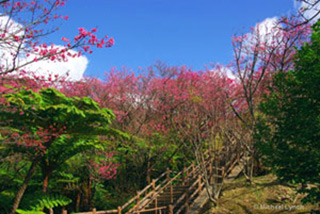
Stairs with handrails ease the climb as the last few hundred yards to the top of Mt. Yadake are rather steep.
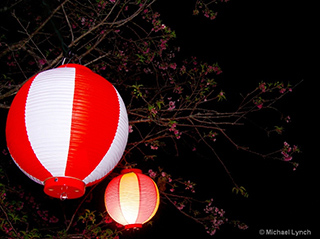
Red and White paper lanterns are strung from the cherry trees lining the road to the festival.
Panasonic DMC-FZ50,
f/2.8, 1/30, ISO 100
As the sun slips down behind the mountains and evening pulls its shade over the landscape, paper lanterns come to life, illuminating the trees with their dim glow for Yozakura, literally translated as Night Sakura. The drinking and celebration continues into the early hours of the morning. However, since Okinawa lacks mainland Japan’s public transportation system, many will watch how much they drink or may not drink at all, recalling their eventual drive back home after the festival slowly dies down. For mainland visitors who are used to the rowdy hanami of sake indulgence, this prudence may give the impression of a quiet and calm celebration.
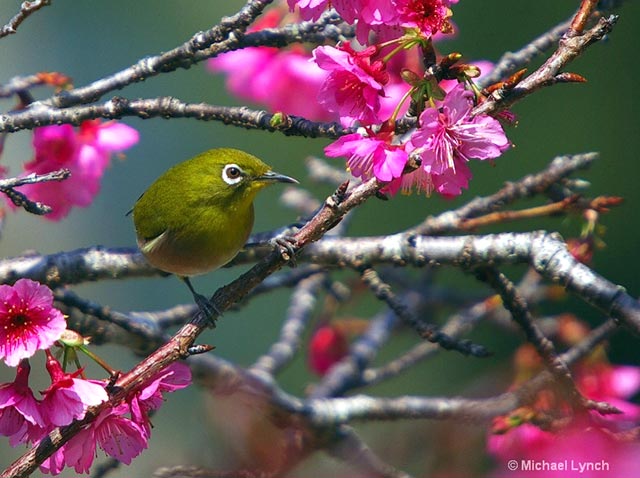
White Eye flitting through Cherry Blossoms…
Equipment Used: Pentax K10D Sigma 50-500 f/6.7 1/1000 ISO 250
The Japanese are not the only ones who enjoy the arrival of the Sakura blossoms. Among the pink branches, the Japanese White Eye bird can be seen flitting from blossom to blossom indulging in its own Awamori. The sweet nectar and pollen of the Sakura attract birds and bees that accent each blossom with their energetic flutter of feathers and casual sleepy hum of wings. Photographers stake out the nearest Sakura tree or sometimes hike long roads up mountains to capture the erratic flight of the Japanese White Eye seeking out a perfect blossom.
The Sakura have been an inspiration to thousands of people throughout the history of Asia. For many centuries, poets and philosophers have sat under its blossoms and watched the wind sweep petals in a pink snowstorm as a symbol of the beautiful yet fleeting nature of life. Royalty and commoners alike have walked long paths littered with petals enjoying the beauty and peace of the blossoms. Yet it was the Samurai who honored the Sakura most. Seeing the lives of its beautiful petals being cut short by uncaring winds as a symbolic representation of their own brief lives–lives they were ready to end by sword in honor of their master, they held the Sakura in high regard and veneration.
the flowering cherries I gazed at speechless
high up on Mount Tatsuta –
will they be shorn and naked before I can see them again?
-Ya Kamochi
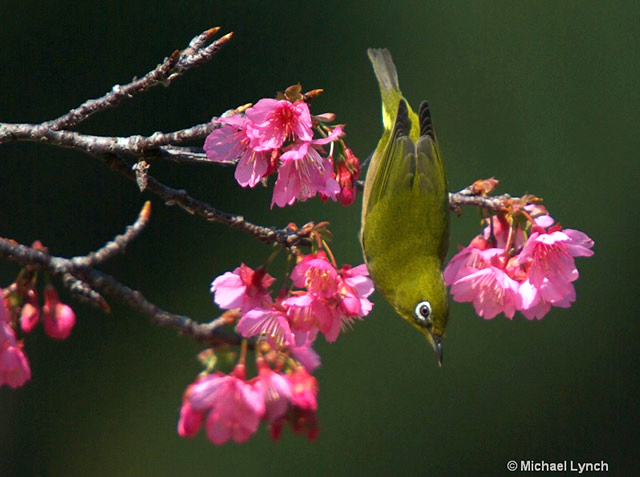
Sometimes it’s a challenge to keep up with these little birds.
For all Japanese, the love of the Sakura and what they represent remains just as strong today. Life is fleeting. We are born, we grow, and then we die. And yet, throughout the brief moments of life, there is magnificent beauty. Those moments captured with the freshly bloomed Sakura are kept close to hearts even as time and life continue to move beyond the framed photographs kept on dusty shelves.
Okinawa is a place of color. With the deep blues and greens of the ocean against the bright blue sky and lush green jungles, it lives up to its title of “tropical paradise.” The splash of pink introduced to the island in the Spring is startlingly beautiful against the already breathtaking scene. As it quickly disappears from the tapestry, replaced by rich Irish green leaf sprouts, the sudden absence of the Sakura leaves onlookers wondering if the flowers were ever really there or if they were merely part of a beautiful daydream of hues. But the photographs are proof that survives beyond the intangible memories of Sakura. Just as the blossoms are whisked away from the branches mere weeks after birth, life quickly passes without rest. Toddlers giggling with innocent joy of life soon grow up to be children learning mathematics, then move away to college and suddenly are married with toddlers of their own. However, the circle continues onward. Children looking up lovingly at their parents under the Sakura will find themselves under the Sakura once more, looking down lovingly at their own children. Centuries from now after our lives are a distant memory, however brief each existence is, the Sakura will remain to comfort and shelter future generations under its blossoms.
Article by Rose Witmer
Photos by Michael Lynch
Article and photos: © 2009 Michael Lynch. All right reserved.

Leave a Reply